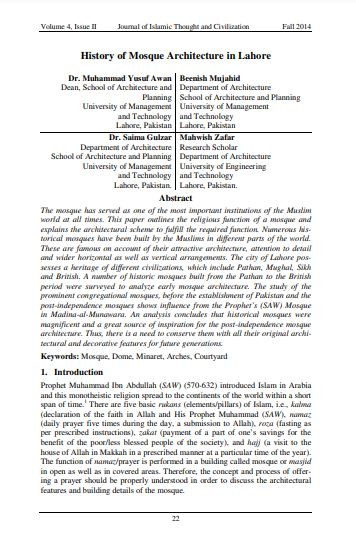
The mosque has served as one of the most important institutions of the Muslim
world at all times. This paper outlines the religious function of a mosque and
explains the architectural scheme to fulfill the required function. Numerous historical mosques have been built by the Muslims in different parts of the world.
These are famous on account of their attractive architecture, attention to detail
and wider horizontal as well as vertical arrangements. The city of Lahore possesses a heritage of different civilizations, which include Pathan, Mughal, Sikh
and British. A number of historic mosques built from the Pathan to the British
period were surveyed to analyze early mosque architecture. The study of the
prominent congregational mosques, before the establishment of Pakistan and the
post-independence mosques shows influence from the Prophet’s (SAW) Mosque
in Madina-al-Munawara. An analysis concludes that historical mosques were
magnificent and a great source of inspiration for the post-independence mosque
architecture. Thus, there is a need to conserve them with all their original architectural and decorative features for future generations.
I agree to the terms outlined below:
You agree to upload and assign Mosqpedia Database the rights to use the content worldwide and in perpetuity across all current and future media platforms. Mosqpedia Database may edit, copy, adapt and translate your contribution.
The content will be distributed under the Creative Commons Attribution-Deed – Attribution-NonCommercial-NoDerivatives 4.0 International – Creative Commons
All data will be stored in line with data protection regulations.